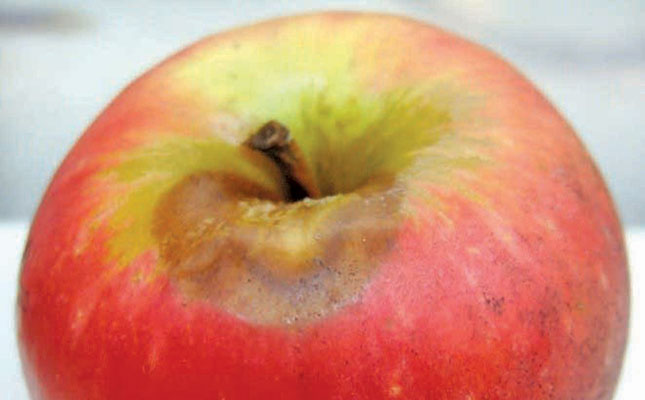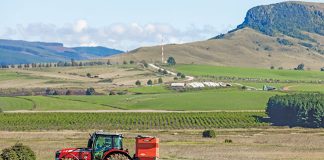
Photo: Supplied
Apple growers in the Western Cape suffer significant post-harvest losses due to the fungus Phylctema vagabunda, which infects the Cripps Pink apple cultivar. Worldwide, the fungus forms part of the bull’s eye rot disease complex on pome fruit. Currently, not much is known about the distribution of the fungus or the extent to which the disease is present on Cripps Pink apples in the Western Cape.
In a recent study published in the journal Plant Disease, Jessica Rochefort, a master’s student in the Fruit and Postharvest Pathology Programme (FPPP) at Stellenbosch University (SU), confirmed the presence and determined the incidence of P. vagabunda on stored commercial Cripps Pink apples in the major apple-growing regions of the Western Cape over three seasons, namely 2010/2011, 2011/2012 and 2012/2013.
The FPPP is led by Dr Cheryl Lennox of SU’s Department of Plant Pathology. P. vagabunda infects the lenticels of apples in the orchard, and symptoms appear only after months in storage.
A molecular detection tool to determine when the fungus is present on Cripps Pink apples and pollinator trees in the orchard was developed as part of the same study. The results showed that P. vagabunda spores were detectable on the apples from December to February and from March to April.
Interestingly, spores were also detected on the crab apple pollinator trees in December and January. Since spores are present on the surface of Cripps Pink apples and pollinator trees during the entire growing season, current management practices in the orchards should be improved.
Managing fungicide
Chemical control is a valuable method to manage post-harvest diseases. In a recent
study published online in the journal Crop Protection, André Russouw, also a master’s student in the FPPP, tested the effectiveness of two fungicides, fludioxonil and pyrimethanil, on Cripps Pink and Fuji apples inoculated with P. vagabunda.
Although both fungicides are used to control other fungal diseases on apples, neither is currently registered for control of P. vagabunda in South Africa.
As part of the experiments, inoculated Cripps Pink and Fuji fruit were dipped and drenched in both fungicides respectively, and the fungicides were also applied as a fog. All three methods are used by packhouses, with the dip and drench treatments being more common.
Because the thermofogging treatment is still new, only fludioxonil is registered for this application. Due to concerns about water use and wastewater created with the conventional methods, this novel approach looks very promising.
The difference in the sensitivity of the inoculated Cripps Pink apples dipped in pyrimethanil, at one and two times the recommended concentration, was evaluated in the laboratory.
The effect of incubation time before treatment in relation to the efficacy of the fungicides was also determined.
It turned out that fludioxonil was highly effective in controlling P. vagabunda when applied as a dip and moderately effective as a drench or thermofog application on both apple cultivars.
Pyrimethanil, on the other hand, was moderately effective on both cultivars only when applied as a thermofog. When applied as a dip, it could not prevent the cultivars from becoming infected.
In contrast, the drench application had little effect on the Fuji cultivar and did not control the fungus on the Cripps Pink cultivar either. There was no variation in the efficacy of pyrimethanil when applied to P. vagabunda at one and two times the recommended concentration.
Incubation time had a significant impact on the efficacy of pyrimethanil. Delaying application of the pyrimethanil decreased its ability to control P. vagabunda. The longer the apples were incubated, the less susceptible the fungi became.
More research is required into the ability of the fungicides to reduce P. vagabunda as post-harvest applications on pre-harvest fruit, whether naturally or artificially infected.
Dr Alana den Breeyen is affiliated with the Weed Pathology Unit at the Agricultural Research Council-Plant Health and Protection in Stellenbosch; Dr Julia Meitz-Hopkins is affiliated with the Fruit and Postharvest Pathology Research Programme at the Faculty of AgriSciences at Stellenbosch University.
Sources: Den Breeyen, A et al. ‘Preharvest detection and postharvest incidence of Phlyctema vagabunda on Cripps Pink apples in South Africa’. Plant Disease. 104 (doi.org/10.1094/PDIS-04-392 19-0818-RE; Russouw, A et al. ‘Postharvest applications of fludioxonil and pyrimethanil to control Phlyctema vagabunda on apples in South Africa’. (doi.org/10.1016/j.cropro).










